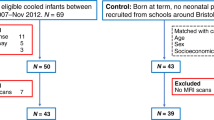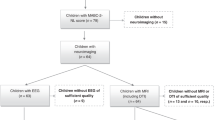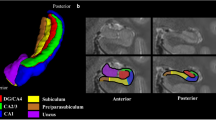Abstract
The objective of this study was to determine whether intelligence and minor motor impairments in children who are born preterm without major disability are associated with cerebral white matter (CWM) and hippocampal abnormalities on magnetic resonance imaging (MRI). A total of 103 preterm children were studied at age 7 y with detailed magnetic resonance brain scans, including a T2-mapping sequence from which T2 relaxation times of the CWM and hippocampal formations were calculated. All of the children had no major motor disability, attended normal school, and had undergone assessment of IQ and a test for minor motor impairment (MMI). Twenty children had visible lesions on MRI, which were associated with lower IQ and more frequent MMI. Mean (SD) IQ was 90 (14.1). Twenty-five children were shown to have MMI (Movement ABC at below the fifth centile). This group was shown to have significantly longer T2 relaxation times for CWM (mean difference 2.1 ms right, 3.1 ms left) but not the hippocampus than the children without MMI. These differences persisted when only children without visible lesions on scans were considered (mean difference 1.5 ms bilaterally). There was no significant correlation between IQ and T2 relaxation times. Children who are born preterm without subsequent major neurodisability may, in addition to visible lesions on MRI scans, have a diffuse abnormality of CWM, manifest as an increase in T2 relaxation time. This abnormality shows a close correlation with minor motor impairment but not with full-scale IQ.
Similar content being viewed by others
Log in or create a free account to read this content
Gain free access to this article, as well as selected content from this journal and more on nature.com
or
Abbreviations
- ABC:
-
movement ABC
- CWM:
-
cerebral white matter
- MMI:
-
minor motor impairment
- MRI:
-
magnetic resonance imaging
- PVL:
-
periventricular leukomalacia
REFERENCES
Marlow N, Roberts BL, Cooke RWI 1993 Outcome at 8 years for children of birth weights of 1250 g or less. Arch Dis Child 68: 286–290
Powls A, Botting N, Cooke RWI, Marlow N 1995 Motor impairment in children 12–13 years old with a birth weight of less than 1250g. Arch Dis Child 72: F62–F66
American Psychiatric Association 1994 Diagnostic and Statistical Manual of Mental Health Disorders, 4th Ed Rev. Washington, DC, American Psychiatric Association
Levene M, Dowling S, Graham M, Fogelman K, Glaton M, Philips M 1992 Impaired motor function (clumsiness) in five year old children: correlation with neonatal ultrasound scans. Arch Dis Child 67: 687–690
Cooke RWI, Abernethy LJ 1999 Cranial magnetic resonance imaging and school performance in very low birth weight infants in adolescence. Arch Dis Child 82: F116–F121
Abernethy LJ, Palaniappan M, Cooke RWI 2002 Quantitative magnetic resonance imaging of the brain in survivors of low birth weight. Arch Dis Child 87: 279–283
Isaacs EB, Lucas A, Chong WK, Wood SJ, Johnson CL, Marshall C, Vargha-Khadem F, Gadian DG 2000 Hippocampal volume and everyday memory in children of very low birth weight. Pediatr Res 47: 713–720
Holland BA, Haas DK, Normal D, Brant-Zawadzki M, Newton TH 1985 MRI of normal brain maturation. Am J Neuroradiol 7: 201–208
Huppi PS, Schuknecht B, Boesch C, Bossi E, Felblinger J, Fusch C, Herschowitz N 1996 Structural and neurobehavioural delay in postnatal brain development of preterm infants. Pediatr Res 39: 895–901
Huppi PS, Maier SE, Peled S, Zientara GP, Barnes PD, Jolesz FA, Volpe JJ 1998 Microstructural development of human newborn cerebral white matter assessed in vivo by diffusion tensor magnetic resonance imaging. Pediatr Res 44: 584–590
Jackson GD, Connelly A, Duncan JS, Grunewald RA, Gadian DG 1993 Detection of hippocampal pathology in intractable partial epilepsy: increased sensitivity with quantitative magnetic resonance T2 relaxometry. Neurology 43: 1793–1799
Di Constanzo A, Di Salle F, Santoro L, Bonavita V, Tedeschi G 2001 T2 relaxometry of brain in myotonic dystrophy. Neuroradiology 43: 198–204
Ullrich K, Moller H, Weglage J, Schurier G, Bick U, Ludolph A, Hahn-Ullrich H, Funders B, Koch HG 1994 White matter abnormalities in phenylketonuria: results of magnetic resonance measurements. Acta Pediatr Suppl 407: 78–82
Dezortova M, Hajek M, Tintera J, Hejcmanova L, Sykova E 2001 MR in phenylketonuria-related lesions. Acta Radiol 42: 459–466
Gay CT, Hardies LJ, Rausch RA, Lancaster JL, Plaetke R, DuPont BR, Cody JD, Cornell JE, Herndon RC, Ghidoni PD, Schiff JM, Kaye CI, Leach RJ, Fox PT 1997 Magnetic resonance imaging demonstrates incomplete myelination in 18q-syndrome: evidence for myelin basic protein haploinsufficiency. Am J Med Genet 74: 422–431
Anderson CM, Teicher MH, Polcari A, Renshaw PF 2002 Abnormal T2 relaxation time in the cerebellar vermis of adults sexually abused in childhood: potential role of the vermis in stress-enhanced risk of drug abuse. Psychoneuroendocrinology 27: 231–244
Ono J, Kodaka R, Imai K, Itagaki Y, Tanaka J, Inui K, Nagai T, Sakurai K, Harada K, Okada S 1993 Evaluation of myelination by means of the T2 value on magnetic resonance imaging. Brain Dev 15: 433–438
Henderson SE, Sugden DA 1992 Movement ABC. The Psychological Corporation, London, UK
Wechsler D 1992 Wechsler Intelligence Scale for Children, 3rd Ed. The Psychological Corporation, London, UK
Bland JM, Altman DG 1986 Statistical methods for assessing agreement between two methods of clinical measurement. Lancet 338: 307–310
Huppi PS, Schucknecht B, Boesch C, Bossi E, Felblinger J, Fusch C, Herschkowitz N 1996 Structural and neurobehavioural delay in postnatal brain development of preterm infants. Pediatr Res 39: 895–901
Peterson BS, Vohr B, Staib LH, Cannistraci CJ, Dolberg A, Schneider KC, Katz KH, Westerveld M, Sparrow S, Anderson AW, Duncan CC, Makuch RW, Gore JC, Ment LR 2000 Regional brain volume abnormalities and long term cognitive outcome in preterm infants. JAMA 284: 1973–1974
Holst L, Grunau RV, Whitfield MF 2002 Developmental coordination disorder in extremely low birth weight children at nine years. J Dev Behav Pediatr 23: 9–15
Elliman AM, Bryan EM, Elliman AD, Walker J, Harvey DR 1991 Coordination in low birth weight seven year olds. Acta Paediatr 80: 316–322
Goyen TA, Lui K, Woods R 1998 Visual-motor, visual-perceptual and fine motor outcomes in very low birth weight children at five years. Dev Med Child Neurol 40: 76–81
Hall A, McLeod A, Counsell C, Thompson L, Mutch L 1995 School attainment, cognitive ability and motor function in a total Scottish very low birth weight population at eight years; a controlled study. Dev Med Child Neurol 37: 1037–1050
Jongmans MJ, Mercuri E, de Vries L, Dubowitz LM, Henderson SE 1997 Minor neurological signs and perceptual-motor difficulties in prematurely born children. Arch Dis Child 76: F9–F14
Luoma L, Herrgard E, Martikainen A 1998 Neuropsychological analysis of the visuo-motor problems in children born preterm at <32 weeks of gestation: a 5 year prospective follow up. Dev Med Child Neurol 40: 21–30
Murphy B, Inder TE, Huppi PS, Warfield S, Zientara GP, Kikinis R, Jolesz FA, Volpe JJ 2001 Impaired cerebral cortical gray matter growth after treatment with dexamethasone for neonatal chronic lung disease. Pediatrics 107: 217–221
Van der Knapp MS, Valk J 1995 Myelin and white matter. In: Magnetic Resonance of Myelin, Myelination and Myelin Disorders, 2nd Ed. Springer-Verlag, Berlin, pp 1–15.
Back SA, Luo NL, Borenstein NS, Levine JM, Volpe JJ, Kinney HC 2001 Late oligodendrocyte progenitors coincide with the developmental window of vulnerability for human perinatal white matter injury. J Neurosci 21: 1302–1312
Berry MA, Abrahamowicz M, Usher RH 1997 Factors associated with growth of extremely premature infants during initial hospitalisation. Pediatrics 100: 640–646
Acknowledgements
We thank Dr. Gillian Lancaster, Lecturer in Medical Statistics at the University of Liverpool, for statistical advice and Dr. Alexia Attard for assistance with data collection. Special thanks are due to G. Hughes, D. Garlick, J. Glynn, H. Tyrer, H. Roper, J. Fleming, and L. Dooley for skill and patience in performing the MRI scans and to the parents and children who gave their time to help in this study.
Author information
Authors and Affiliations
Corresponding author
Additional information
This project was funded by Research Grant MC 010696 from the National Lottery Charities Board, U.K.
Rights and permissions
About this article
Cite this article
Abernethy, L., Klafkowski, G., Foulder-Hughes, L. et al. Magnetic Resonance Imaging and T2 Relaxometry of Cerebral White Matter and Hippocampus in Children Born Preterm. Pediatr Res 54, 868–874 (2003). https://doi.org/10.1203/01.PDR.0000091285.84577.4E
Received:
Accepted:
Issue date:
DOI: https://doi.org/10.1203/01.PDR.0000091285.84577.4E
This article is cited by
-
Mental health assessed by the Strengths and Difficulties Questionnaire for children born extremely preterm without severe disabilities at 11 years of age: a Norwegian, national population-based study
European Child & Adolescent Psychiatry (2017)
-
Decreased postural control in adolescents born with extremely low birth weight
Experimental Brain Research (2015)
-
TIPIT: A randomised controlled trial of thyroxine in preterm infants under 28 weeks' gestation
Trials (2008)
-
TIPIT: A randomised controlled trial of thyroxine in preterm infants under 28 weeks gestation: Magnetic Resonance Imaging and Magnetic Resonance Angiography protocol
BMC Pediatrics (2008)



